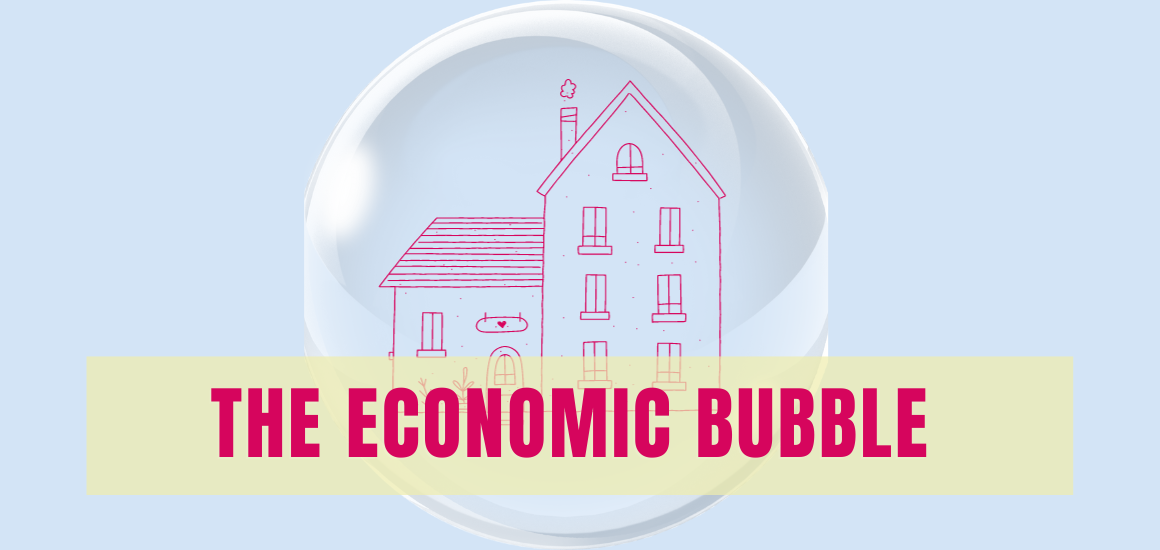Economics, often called the “dismal science,” is far from dismal when one delves into its intricacies. It studies how societies allocate their limited resources to meet their infinite wants and needs. Behind every financial decision, from a household’s monthly budget to a nation’s monetary policies, lies something fascinating about the concept of economics.
One such event is “The Bubble.” Just like a soap bubble that you might have noticed is so pleasant to look at with its increasing size. But as soon as it inflates, you never know when it may pop. Isn’t it? All the while, it may not be discerning to notice a soap bubble pop up, but in reality, if there is an economic bubble, it is something that can put you in distress.
What is an economic bubble anyway?
It is a phenomenon where a particular asset is overvalued beyond its intrinsic value. That usually occurs when the prices inflate, but at a certain point, what inflates has a probability of deflating. The sudden drop in prices can’t be easily predicted, and hence, a bubble can burst at any point in time.
Take the situation in the past, whether it is about the tulip bulb incident or the housing crash; every bubble indicates common characteristics.
What’s the phenomenon behind it?
It all arrives with speculative behavior, where the purpose of the investor is not to buy an asset because it has an inherent value nor for its potential to make income but to sell it later at a higher price. The speculation fuels the prices, and they increase, in turn, attracting many other investors who want to buy.
The behavior of the investors in this situation is to be overly optimistic while ignoring all the warning signals to make more money, believing that “this time is going to be different,” which is technically called irrational exuberance, leading them to unsustainable levels of prices.
While some might leverage the opportunity to exit at the right time to make profits, some end up waiting for more, resulting in losses that are sudden. On the other hand, if there is easy access to credit, it triggers individuals to be risk-takers and initiate asset purchases, which mostly happen due to loose monetary policies.
Stocks Might be Eye Catchy Bonds are Relaxing Though
The anatomy of the bubble clearly looks like this
Stealth phase: When a new investment is introduced in the market, it has the potential to attract only new investors while being fairly unknown to many others.
Awareness Phase: Media attention and word-of-mouth start to spread, drawing more participants into the market.
Mania Phase: Frenzied buying and rapid price increase happens at this stage. Speculation reaches its peak, and everyone seems to be discussing the investment.
Blow-off Phase: At this point, prices skyrocket, often doubling or tripling quickly. Fear of missing out (FOMO) drives more people to invest.
Crash Phase: The bubble bursts, and prices plummet. Panic selling takes hold, and many investors suffer substantial losses.
The notable historical bubbles in the past
Throughout history, numerous economic bubbles have left their mark. Some notable examples include:
Tulip Mania (1637): In the Dutch Golden Age, tulip bulbs became a speculative asset, with prices soaring to astronomical levels before collapsing.
South Sea Bubble (1720): In Britain, shares of the South Sea Company surged to unsustainable levels before crashing, leading to financial ruin for many.
Dot-Com Bubble (2000): The late 1990s saw a mania around internet-related stocks, with many companies experiencing stratospheric stock price increases before the bubble burst.
Housing Bubble (2007-2008): The widespread speculation in the U.S. housing market, driven by lax lending practices, resulted in a catastrophic financial crisis.
Fueling India’s Economic Woes: The Surging Oil Prices Story
What do we learn from here?
Economic bubbles have, time and again, demonstrated the importance of vigilance and prudence in financial markets.
Regulation: Strong financial regulation and oversight are crucial to prevent bubbles from forming and bursting with catastrophic consequences.
Market Psychology: Understanding investor psychology and the role of emotions in financial decision-making is vital for investors, policymakers, and regulators.
Diversification: Diversifying investments can help mitigate the impact of a bubble burst on an individual’s portfolio.
Long-Term Perspective: Investors should adopt a long-term perspective and avoid chasing short-term gains based on speculative fervor.
The Wrap
Economic bubbles are more than just financial phenomena; they are a vivid reflection of the remarkable interplay between human psychology and finance. Through the lenses of irrational exuberance and the fear of missing out, we have explored how these bubbles form, inflate, and inevitably burst, leaving a trail of valuable lessons.
Bubbles are cautionary tales, reminding us to approach investments with diligence and rationality. These lessons include diversifying our portfolios, adopting a long-term perspective, staying informed, and promoting financial literacy.






